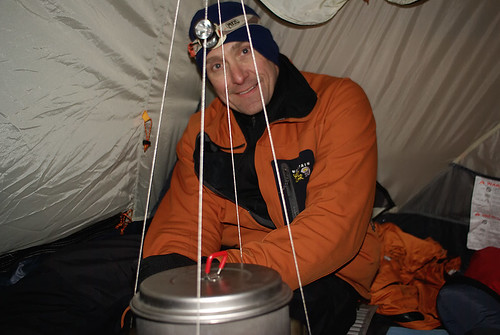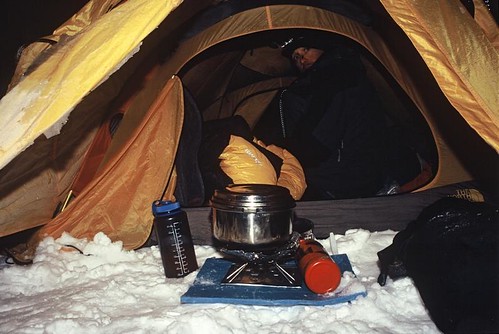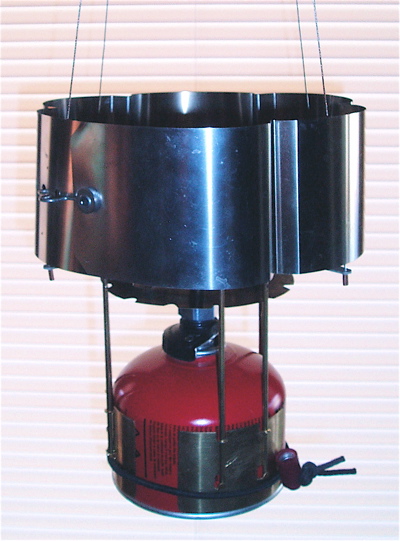When I ask serious northeastern
Well, I'm letting the genie out of the bottle. I'm going to demystify the hanging system and give you a little insight as to why it makes winter camping so much easier.
What is the purpose of the hanging stove system? Basically it eliminates the elements from your biggest winter chores; creating drinkable water through the melting of snow and ice, hydrating, and eating.
Traditionally people would sit outside their tent and melt snow, this is a process that even with the most powerful portable stoves can take hours for a group of 2-3 people. So for 2 hours or so you must wear lots of extra clothing that you probably wouldn't otherwise need to carry. Then you must eat more to generate body heat. So you have to carry even more food. All the while you are probably pretty cold.
Other options to sitting outside include cooking/melting in the vestibule of your tent. However, this isn't completely weather proof in seriously bad storms. The stove is typically more exposed to the elements and so are you. I've been a prolific winter vestibule snow melter for years as a compromise to hanging the stove inside the tent, it cost nothing, and is deemed by some to be safer. If using a white gas stove, this is still the mode of choice that I prefer. The reason of course, is even those who are at Zen with their white gas stoves, tend to have an occasional flare up, and a flare up is not a good thing if it’s in the tent, or under the closed vestibule. However, you can get the stove going safely at the edge of the vestibule, then bring it into its permanent home, get in your sleeping bag and boil away.
 You can build a hanging stove for white gas or canister stoves like the MSR XGK or Firefly for under $20. The Superfly is my stove of choice, and I use a hanging kit made by MSR that was difficult to find, but works well enough in a tent. This setup might not be the cats meow hanging from a big wall on a portaledge though since it is pretty light, and some might say a bit flimsy looking. I mainly like it because it is compact and light. I know Bibler makes a hanging system, as does Markhill and there are a few other brands, I also think JetBoil makes some sort of hanging adapter.Also, MSR recently came out with the "Reactor" which is a brand new hanging system that isn't cheap. Actually, unless making your own, be prepared to drop about $100 on the cheapest setup, and up to $200 on more expensive ones.
You can build a hanging stove for white gas or canister stoves like the MSR XGK or Firefly for under $20. The Superfly is my stove of choice, and I use a hanging kit made by MSR that was difficult to find, but works well enough in a tent. This setup might not be the cats meow hanging from a big wall on a portaledge though since it is pretty light, and some might say a bit flimsy looking. I mainly like it because it is compact and light. I know Bibler makes a hanging system, as does Markhill and there are a few other brands, I also think JetBoil makes some sort of hanging adapter.Also, MSR recently came out with the "Reactor" which is a brand new hanging system that isn't cheap. Actually, unless making your own, be prepared to drop about $100 on the cheapest setup, and up to $200 on more expensive ones.
My MSR branded hanging kit is a folding cross shaped piece of titanium with some metal braided cable to support the stove from a central tie in point. There is a metal contraption that keeps the flames, heat, and pot contained, and another piece of metal that keeps the canister from getting too warm.
The whole setup weighs almost nothing (lets say 4-6oz tops), and in conjunction with a Superfly probably weights half of what a comparable white gas setup weighs. I'd venture to say, space and weight considered, this is the lightest and most compact hanging stove on the market, and efficient to boot!
In the above photo the use of a conduit is seen on the MSR Superfly Ascent system
photo: (C) Chipskiff @ flickr
Finally, I use a fairly small pot, so I don’t over work the stove. I also use a 2/3 cup measuring spoon to remove water from the pot, so the pot always remains on the stove. This makes siphoning water off to make tea, or fill water bottles simple. It also makes measuring for my dehydrated meals simple.
An alternative to this would be to use a titanium or aluminum mountaineering tea kettle. These are incredibly heat efficient, and contain the water for easy pouring.
There is one draw back to butane/propane canister stoves. Below about 40F the stoves get finicky. Butane doesn’t do well in cold, and the isobutane/propane additive makes it slightly better, however, it still requires a little TLC until the stove is warmed up.
I recommend shaking the canister gently and warming it initially in your hands or sleeping bag. Bring a few chemical hand warmers, and tape one to the bottom of the canister for initial warming. Once you have some water heated, you can take a very small amount and put it in a pot top, plate or bowl, then put it under the canister for a few seconds every now and then. This keeps the mixture flowing equally. The problem is the propane on a cold canister burns off first, and the butane is left over. A little warming solves this while really firing the stove up.
I’ve found that you need to resort to constant rewarming only if you let the propane burn off initially, as the tent warms up the stove does quite well.
Some people add a heating coil to the canister, which is essentially just a wire or conduit that goes from the flame to the canister. If you set this up well, it’s probably the ideal solution. The propane and butane burn off evenly with constant heat flow, but some people are uneasy with heating a canister directly.
Speaking of directly, you can also light a lighter under it if you get desperate. I really don’t recommend this, although it isn’t nearly as dangerous as it sounds. If you are warm, just put your hand on the canister and that should be fine. Or insulate the canister and drop the hand warmer in it.
I prefer the smaller 4oz canisters, because they put less weight on the stove, and take up less space. For a group of 2, I’d say 2 canisters per night. Playing it safe, 3 per day. This obviously is quite a bit more expensive than white gas which requires about the same amount of fuel (4oz/person/day) but at a lower cost per ounce. That said, the cost is really pretty low for an occasional overnight, or even a 2 night trip when split between 2 people. This wouldn’t be my preference for long distance trips, or frequent use though.
So let me concisely explain the benefits of the hanging stove.
1) Simply more efficient (for the following reasons)
2) Weighs less
3) Burns less fuel
4) Requires you to eat less to stay equally warm, or actually far warmer because you burn fewer calories, thus you require less food.
5) Protects you from the elements in really poor conditions that you might decide to no even bother breaking out the stove (this happened to me once in
6) Reduces clothing required to stay warm at camp, which is the bulk of your clothing. Keep in mind, a four season tent, properly vented, will get to between 30-40F with a hanging stove no matter how cold it is outside.
7) Actually allows clothing to dry out in the Northeast (and other wet places like the Cascades), despite the steam from the water, the air actually gets warm and dry from the stove, and condensation is all but eliminated keeping the tent interior drier.
8) Allows you to hydrate in comfort. Remember unless you are using solar stills, or drinking from a spring, all your water in winter is generally from melting snow. You are more prone to consume adequate quantities of water if you are warm and dry. Your pee definitely should be almost clear before you head to bed.
9) Being hydrated means being warmer, means hiking faster, means sleeping better.
10) Cost slightly more, but is probably more efficient per oz of fuel.
Now there is a valid counter point, some people say, “but I backpack to be one with nature, not to sit in a tent.” And that is a fair point, actually it’s a darn good argument. However, before you decide to be “one with nature” consider the fact that I outlined the benefits to the hanging system, which include carrying less weight, and thus covering more ground per trip. Basically what is comes down to is, are you backpacking/climbing or camping? If you are camping, and perhaps even making a fire, by all means my system is for the birds. If you have a goal to cover ground, or carry technical climbing equipment, then it’s vastly superior.
I have heard many arguments that don’t hold water (no pun intended). Such as drinking too much at camp means you will have to get up and pee, and thus be colder. I’ll be honest, I never get up at night at home, but I rarely don’t while camping, and laying in your bag thinking about having to pee is not good for sleep. If you are that concerned with the issue, bring a pee bottle…or be one with nature, get up for 2 minutes, pee and get back in your warm sleeping bag, fully hydrated and ready to go. Not being hydrated so you don’t have to pee is simply a boneheaded argument.
Finally of course is safety, you do need to ventilate the tent. That means that no matter how appealing it will be to seal the tent up, and just let the stove run, it’s a really bad idea. You also need to be cognizant that flare ups CAN occur with any stove no matter how often you have used it, so make sure the stove is primed properly before it gets anywhere near tent fabric, and of course make sure it stays at least a foot from anything flammable.
By no means is my (and by my, I mean my preferred system) superior in all circumstances. But for those looking to bivy in hostile climates such as exposed ledges, summits, or during severe winter storms and extreme cold, this is definitely the ticket to being more comfortable and efficient.
And one last thing, for those who have never melted snow, make sure you have water (liquid) in the put before you start melting. While you probably are doubting this, snow does burn to the bottom of the pot, and it taste horrible. Start with any water you can find, and very slowly add snow.














Dude, that is quite hardcore in my book. Impressive!
ReplyDelete-Somanna
Thanks! Although more wussy than hardcore since we are sort of living a warm indoor life.
ReplyDelete